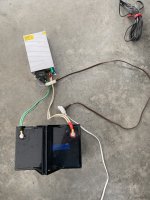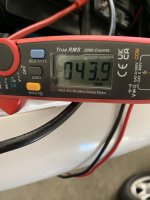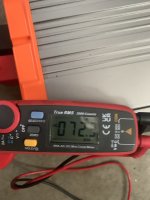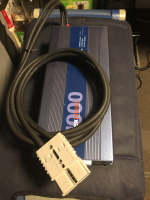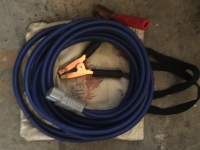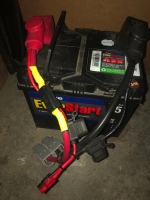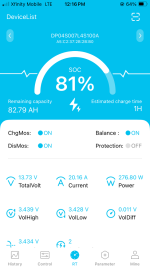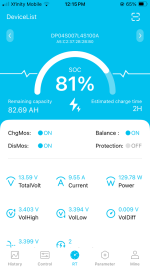Congratulations on Dave’s advice and now having a functional DC-DC for one of your batteries!
If I already had a DC-DC charger installed, I would not do the direct wire method since that seems more than enough amps based upon your past experience with that battery.
Yes, the brown cord from front to back on a previous picture is a cheap, burn your house down, 20’ 16 gauge extension cord with the ends cut off and Andersons installed. I already had Andersons on short wires to the batteries. Direct connection. About 6 amps. About 12’ of #10 wire gives a little over 20 amps. Fused, if permanent.
Back to the 120vac inverter at the start battery, extension cord to the rear, and a battery charger (power supply) plugged into the extension cord. That’s what you see in the pictures below. The 20’ white extension cord is another el cheapo #16.
The pictures below also show that 40 amps of battery charging at the rear required 43.9 amps of charging current from the vehicle into the inverter up front. Not too shabby. Works for me with a 130 amp alternator at idle. Another picture shows 72.3 amps when I adjusted the charging amps to 70. A clamp-on DC ammeter is a valuable tool.
That means that however many 12v amps you need at the rear requires a few more from the front (alt). Using the about 10:1 rule of thumb for inverters, 120v, 15amps into your camper means about 150 amps from your vehicle/alternator. 15 amps X 10. That means about 150 alternator amps to produce 15 amps from an inverter to equal a 15 amp 120vac trailer hookup.
That same 10:1 means my 40 charging amps equals about 4 amps through the extension cord.
The 1000 watt inverter you mentioned could provide about 8 amps of 120v and require about 80 amps from the vehicle, and provide about 80 amps of battery charging at the camper.
My 10 year old camper trailer’s converter (inverter) outputs less than 14vdc except for short equalization periods that are higher than the lifepo4s supposed maximum. I need to investigate further.
I plan to use the power supply (charger) seen below instead of the trailer's converter when shorepower is available, or gggrrrr, when I HAVE to fire up that noisy-ass, supposedly quiet inverter generator.
If I already had a DC-DC charger installed, I would not do the direct wire method since that seems more than enough amps based upon your past experience with that battery.
Yes, the brown cord from front to back on a previous picture is a cheap, burn your house down, 20’ 16 gauge extension cord with the ends cut off and Andersons installed. I already had Andersons on short wires to the batteries. Direct connection. About 6 amps. About 12’ of #10 wire gives a little over 20 amps. Fused, if permanent.
Back to the 120vac inverter at the start battery, extension cord to the rear, and a battery charger (power supply) plugged into the extension cord. That’s what you see in the pictures below. The 20’ white extension cord is another el cheapo #16.
The pictures below also show that 40 amps of battery charging at the rear required 43.9 amps of charging current from the vehicle into the inverter up front. Not too shabby. Works for me with a 130 amp alternator at idle. Another picture shows 72.3 amps when I adjusted the charging amps to 70. A clamp-on DC ammeter is a valuable tool.
That means that however many 12v amps you need at the rear requires a few more from the front (alt). Using the about 10:1 rule of thumb for inverters, 120v, 15amps into your camper means about 150 amps from your vehicle/alternator. 15 amps X 10. That means about 150 alternator amps to produce 15 amps from an inverter to equal a 15 amp 120vac trailer hookup.
That same 10:1 means my 40 charging amps equals about 4 amps through the extension cord.
The 1000 watt inverter you mentioned could provide about 8 amps of 120v and require about 80 amps from the vehicle, and provide about 80 amps of battery charging at the camper.
My 10 year old camper trailer’s converter (inverter) outputs less than 14vdc except for short equalization periods that are higher than the lifepo4s supposed maximum. I need to investigate further.
I plan to use the power supply (charger) seen below instead of the trailer's converter when shorepower is available, or gggrrrr, when I HAVE to fire up that noisy-ass, supposedly quiet inverter generator.

